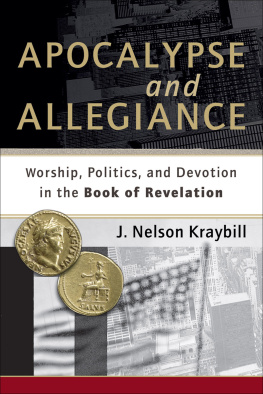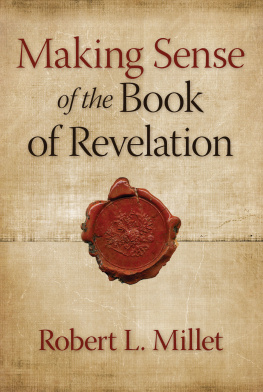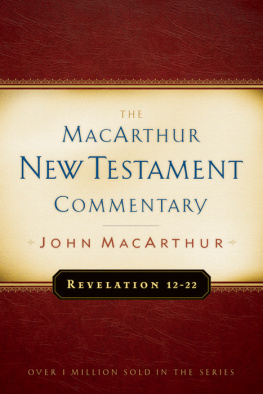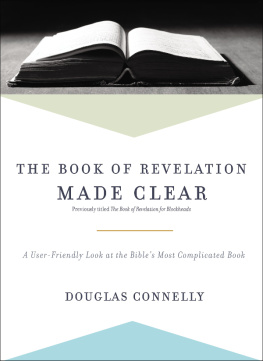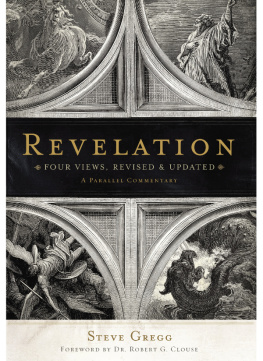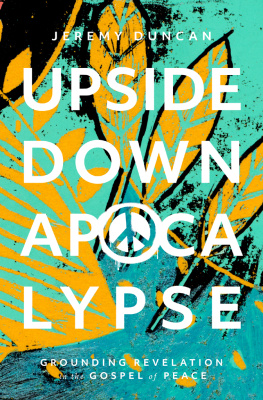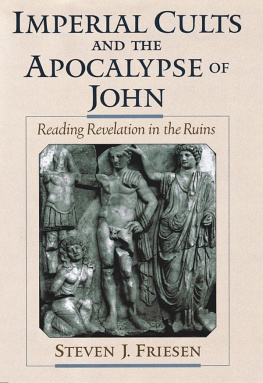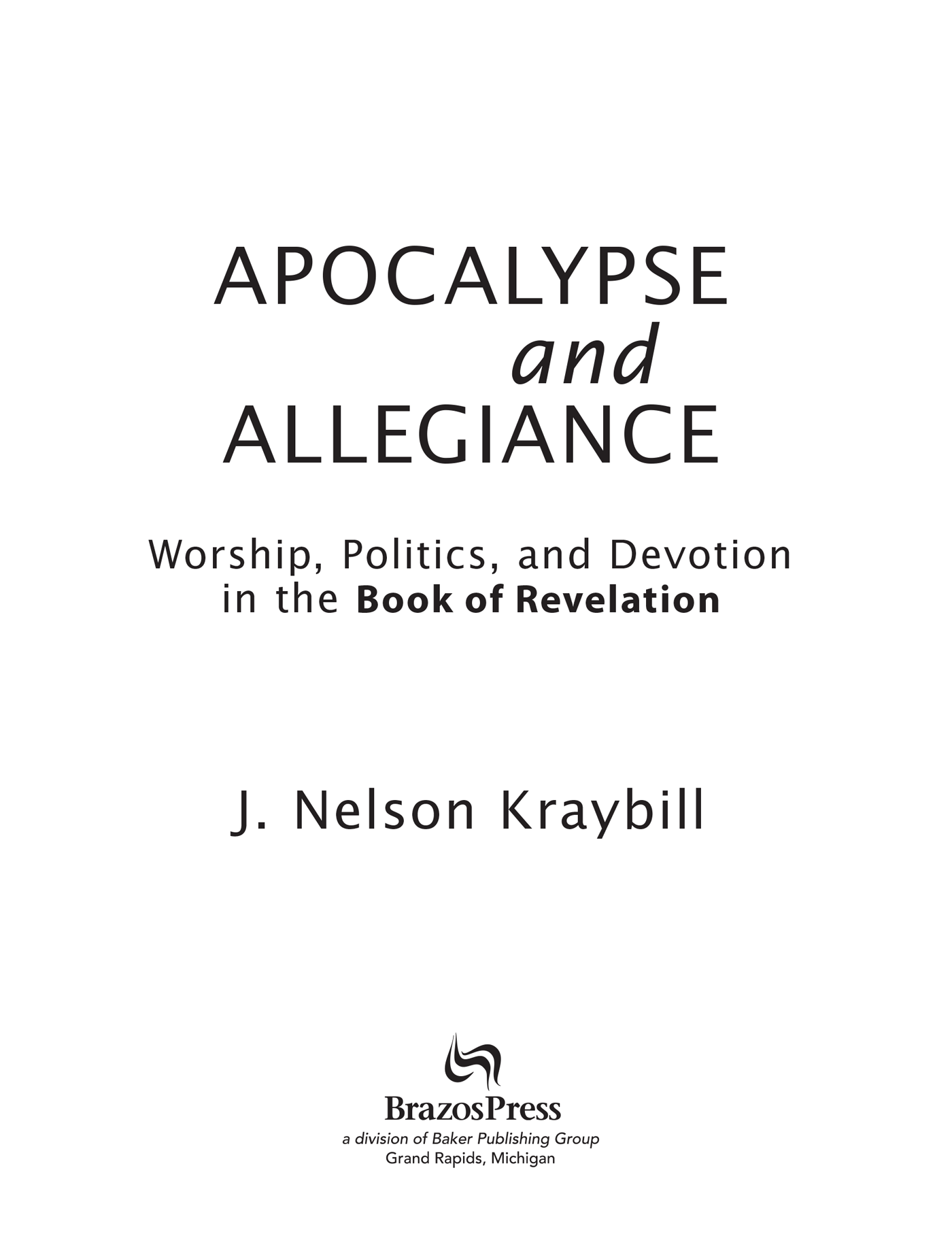
To my daughter Andrea,
visionary artist and
intrepid follower of the Lamb
Gods reign is already present on our earth in mystery.
When the Lord comes, it will be brought to perfection.
That is the hope that inspires Christians.
We know that every effort to better society,
especially when injustice and sin are so ingrained,
is an effort that God blesses,
that God wants,
that God demands of us.
Words spoken by Archbishop Oscar Romero as he celebrated Eucharist on March 24, 1980, at the chapel of Divine Providence Cancer Hospital in San Salvador. In preceding months Romero had summoned the people of El Salvador to nonviolent resistance against a repressive military regime. As he finished his eucharistic homily, a single bullet from an assassin ended his life (James R. Brockman, The Church Is All of You: Thoughts of ArchbishopOscar Romero [Minneapolis: Winston, 1984], 110).
Contents
Thirty years ago students at an urban high school in San Juan, Puerto Rico, dared me to teach the book of Revelation. Accepting the challenge, I steeped myself in commentary and history to understand Johns vision. When placed in historical and literary context, Revelation began to make sense. By the end of the semester, my students had made a poster-sized cartoon strip of Johns vision that encircled the classroom, and I had acquired a lifelong fascination with Revelation. In subsequent years I learned more about the last book of the Bible from teachers, colleagues, and students, including the following:
Professor Paul Achtemeier, my adviser when I wrote a doctoral dissertation on Revelation at Union Theological Seminary in Virginia. The dissertation was published as Imperial Cult and Commerce in JohnsApocalypse (Sheffield: Sheffield Academic Press, 1996), and as Cultoe Comrcio Imperiais no Apocalipse de Joo (So Paulo: Paulinas, 2004).
Students in my classroom in Uruguaysome of whom had been incarcerated and tortured by a military regime in that countrywho helped me understand that modern empire can warp values and allegiances in ways similar to ancient Rome.
Loren Johns, my faculty colleague at Associated Mennonite Biblical Seminary in Elkhart, Indiana, whose specialties include Lamb Christology. We taught Revelation together and jointly led a study tour to the seven cities of Revelation and Rome.
People at congregations, denominational assemblies, seminaries, colleges, and universities in the United States, Canada, England, Ireland, Japan, Korea, Spain, and Uruguay who contributed insights when I had the privilege of teaching Revelation in those countries.
In addition to studying Revelation on a scholarly level, I aspire to teach Johns vision in ways that are accessible to a general audience. This book grew out of such efforts. It includes photos and graphics throughout, a minimum of footnotes or rehearsal of scholarly debates, and some contemporary application. Associated Mennonite Biblical Seminary generously granted me a summer sabbatical, during which I wrote much of this volume. I took many photos on these pages on the three occasions when I collaborated with Tour-Magination of Waterloo, Ontario, to lead study groups to biblical sites in Israel/Palestine, Turkey, and Italy.
I am grateful to Rodney Clapp of Brazos Press for encouraging me to write this book and for shepherding it through the editorial process. The editorial team of Brazos Press masterfully ironed out theological, historical, and hermeneutical wrinkles throughout the manuscript. Others who contributed by critiquing drafts at various stages include Barbara Nelson Gingerich, Loren Johns, Alan Kreider, Eleanor Kreider, Gene Lackore, Mary Lackore, and Heidi Siemens Rhodes. To each of these generous persons I owe much, with the greatest debt to my wife, Ellen Graber Kraybill, who read this book at several stages and was a constant source of encouragement.
J. Nelson Kraybill
Elkhart, Indiana
Good Friday, 2009
| ANF | Ante-Nicene Fathers. Edited by A. Roberts and J. Donaldson. 10 vols. 1885-1896. Reprint, Peabody, MA: Hendrickson Publishers, 1994 |
| CIL | Corpus inscriptionum latinarum. Edited by T. Mommsen et al. Berlin-Brandenburg: Deutsche Akademie der Wissenschaften, 1863 |
| JSNTSup | Journal for the Study of the New Testament: Supplement Series KJV King James Version |
| LCL | Loeb Classical Library |
| NIV | New International Version |
| OGIS | Orientis graecae inscriptiones selectae. Edited by W. Dittenberger. 2 vols. Leipzig: S. Hirzel, 19031905 |
| RSV | Revised Standard Version |
| WBC | Word Biblical Commentary |
| WUNT | Wissenschaftliche Untersuchungen zum Neuen Testament |
Introduction
Worship Is Political
Not long after the 2001 terrorist attacks in the United States, I received an unsettling letter from Trevor, a college friend whom I had not seen for twenty-five years. In our youth we both were persuaded by Jesus call to peacemaking and love of enemies. But the church Trevor attended in 2001 was not bound to nonviolence, and people there were reeling from a double loss in the terrorist attacks. Among passengers on the plane that plunged into the Pentagon was the granddaughter of a woman from Trevors congregation. And Todd Beamer, who helped to organize a passenger revolt on the plane that went down in Pennsylvania, was a friend of the pastor. The trauma of these tragedies and fear of further terrorism triggered a shift in Trevors ethics and allegiance.
In his letter, Trevor described a worship service at his congregation on the Sunday after the attacks:
The Christian flag was at the front of the church. As we sang God Bless America, the newest mother in the congregation brought the US flag forward in a funeral marchone step per two beats. I have not felt that filled with the Holy Spirit nor had tears streaming down my face at any service in my memory as I did during that one. When the US flag joined the Christian flag at the front of the church, it looked exactly right. I vowed not to make an issue of whether the national flag should stand at the front of the church as I had at a previous congregation.
Explaining that he no longer held to the nonviolent ideals of his youth, Trevor wrote:
I have always felt that the turn the other cheek lesson of the gospel was a lesson against vengeance. As a Christian, there is no room in my religion for making war to gain vengeance. Making war to prevent the further senseless slaughter of my countrymen is perfectly justified, however. If my identity as an American makes me a target, I have an obligation to defend myself, my family, and my neighbors. By choosing to massively attack innocent people, the perpetrators have lost any right to have their point of view considered by civilized people. Whatever happens to them now is their just due, the morality of which needs no further consideration or soul-searching on my part.
Symbols Help Persuade
Many factorsincluding anger, fear, and shockmust have played into Trevors shift of attitude toward violence and political allegiance. But what stands out in events leading to his change of conviction is the significant role of symbol at each stage. Terrorists struck the World Trade Center (a symbol of economic might) and the Pentagon (a symbol of military power). The perpetrators had also apparently intended to attack the United States Capitol building (a symbol of political power) but were thwarted by a passenger revolt.
Next page
